Beneficial insects
Honey bees and other insects help pollinate cotton. Cotton is primarily a self-pollinator, but it is partially pollinated by insects. These insect pollinators help set a good crop and good cross pollination is desirable; therefore, the selection and timing of insecticide application should be considered when pollinators are present in the field. Pollinators tend to leave cotton fields by midafternoon, but pest species may remain active into the night. Insecticides application later in the evening helps to minimize harm to pollinators while maximizing control of the pest species.
Numerous beneficial insect and arthropod species can be found in cotton fields attacking pest species. These beneficial species attack the egg, immature (larval, nymphal and pupal), and adult stages of most pest species. Both beneficial parasitoid and predatory species are present throughout the field season. In addition to the beneficial arthropods, numerous disease organisms may infect cotton pests and further limit their population growth.
Ants
Ants are important and overlooked predators in cotton fields. Several different species may inhabit fields as the worker caste ants (approximately 1/8 inch in length, wingless, and with a narrow waist) forage for insect eggs and larvae. Ants are an important predator of bollworm eggs and larvae.
Assassin bugs and other piercing-sucking predators
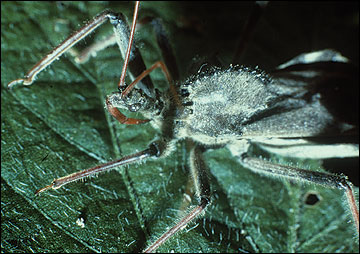 Figure 47
Figure 47
Assassin bug adult.
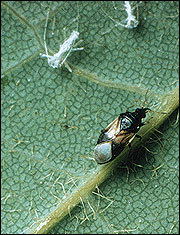 Figure 48
Figure 48
Minute pirate bug adult.
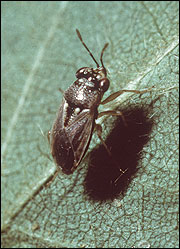 Figure 49
Figure 49
Big-eyed bug adult.
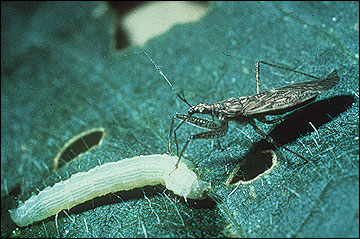
Figure 50
Damselbug adult.
Several different species of assassin bugs (yellow to black coloration) are predators of both immature and adult stages of insects (Figure 47). These piercing-sucking insects readily attack the large larval stages of lepidopteran insects (e.g., bollworm). It is important to exercise caution when handling these insects because their bite is very painful.
Other piercing-sucking predators include several species each of big-eyed bugs, damsel bugs and minute pirate bugs. Minute pirate bugs (about 1/8 inch in length, black) are the most common of this predatory group (Figure 48). They attack thrips, aphids, mites and bollworms (eggs, small larvae). Both big-eyed bug adults and nymphs also frequently attack thrips, plant bugs, bollworms (eggs, small larvae), and many other insects. Adults are about 1/4 inch long with big eyes and gray to black coloration (Figure 49); nymphs are bluish gray. Damsel bugs (about 1/2 inch long, slender with long legs) (Figure 50) are less common, but they also attack plant bugs, spider mites, and bollworms (eggs, small to medium-sized larvae).
Lacewings
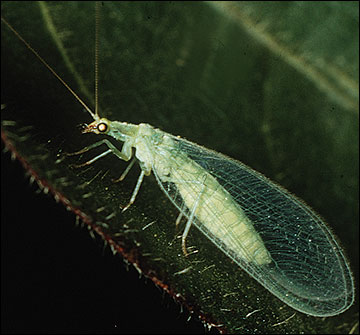 Figure 51
Figure 51
Green lacewing adult.
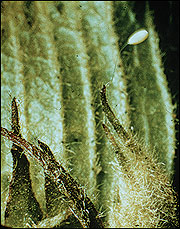 Figure 52
Figure 52
Lacewing egg.
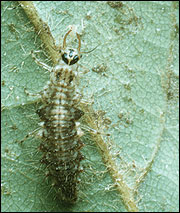 Figure 53
Figure 53
Lacewing larva.
Two lacewing species (brown and green) occur in cotton fields, but the green one is more commonly found. Adult lacewings are fragile in appearance with long antennae and large wings with many pronounced veins (Figure 51). Female lacewings deposit their white eggs at the end of long, threadlike stalks (Figure 52). The larval stage is a mottled brown with long sickle-shaped mouthparts (Figure 53). Adults may feed on insect eggs, but the larvae are more important because they are voracious predators of aphids and bollworms (eggs and small larvae). A single lacewing larva can consume more than 40 bollworm eggs in one day.
Ladybird beetles
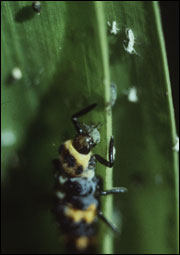 Figure 54
Figure 54
Ladybird beetle larva attacking aphids.
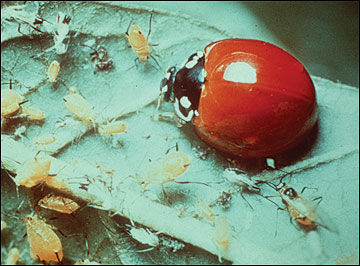 Figure 55
Figure 55
Ladybird beetle attacking aphids.
 Figure 56
Figure 56
Syrphid larva attacking aphids.
Many species of ladybird beetle can be found in cotton fields. They range in size from 3/100 to 1/2 inch in length, are orange to black in coloration, and may or may not possess spots. The eggs (yellow-orange, football-shaped) are laid singly or in masses of 10 or more depending on the species. The larval stage is typically "alligator-shaped" and black with brightly colored markings. Both larval and adult stages (Figures 54 and 55) of ladybird beetles prey upon aphids, spider mites, the eggs and larvae of most lepidopteran cotton pests (e.g., cotton bollworm), and other soft-bodied insects.
Other predatory arthropods occasionally found in cotton fields include ambush bugs, earwigs, ground beetles, spiders, syrphid flies (Figure 56) and tiger beetles.
Parasitoid flies and wasps
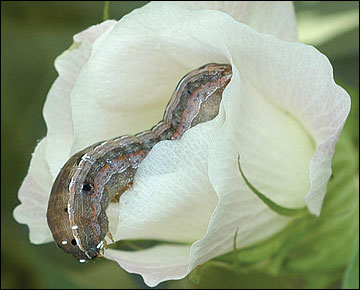 Figure 57
Figure 57
Parasitized yellowstriped armyworm larva in cotton blossom.
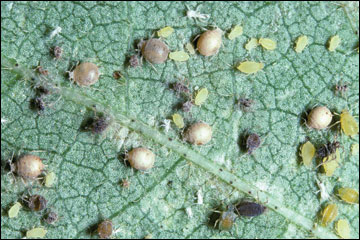 Figure 58
Figure 58
Mummified aphids.
 Figure 59
Figure 59
Wasp parasitoid of cotton aphids.
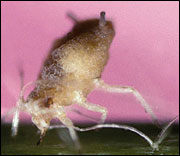 Figure 60
Figure 60
Neozygites fresenii-infected aphid.
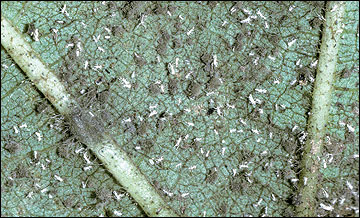 Figure 61
Figure 61
Aphid bodies overgrown by saprophytic fungi after being killed by Neozygites fresenii.
Several parasitoid species of flies and wasps may attack cotton pests (Figure 57), especially aphids and the larvae of lepidopteran pests. Various tiny wasps regularly lay their eggs inside the bodies of aphids. Within a few days the aphids are paralyzed, become swollen and discolored, and eventually die (Figure 58). Several days later, the adult wasp (Figure 59) emerges through a circular hole cut in the "mummified" body of the aphid. Other tiny wasps and parasitic flies attack the egg or larval stage of armyworms, bollworms, loopers, and other lepidopteran cotton pests.
Several naturally occurring pathogens also may infect and reduce populations of cotton pests. For example, epizootics or outbreaks of the fungal pathogen Neozygites fresenii can rapidly reduce cotton aphid infestations within 7 to 10 days. Infected aphids typically die with their mouthparts still inserted into the leaf and are covered with a velvety white or light gray growth (Figure 60). Later, secondary pathogens infect the aphid bodies, giving them a fuzzy olive-brown appearance (Figure 61). Other pathogens (fungal or viral) are specific to lepidopteran pests and kill their hosts within a few days after infection. Infected, dead larvae (discolored) are typically found hanging from the bottom of a leaf (viral) or standing erect on a leaf (fungal). The viral particles or fungal spores are eventually released back into the environment to infect another generation of pests.